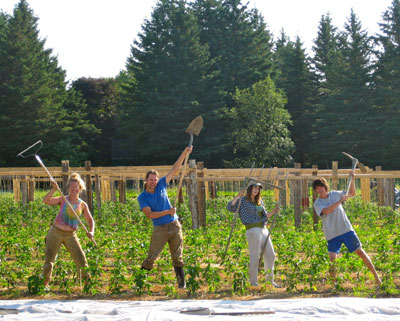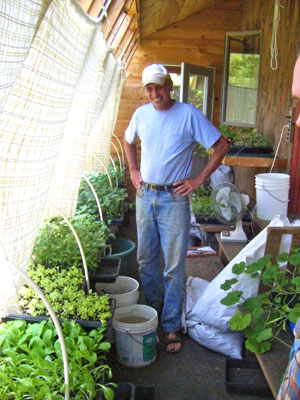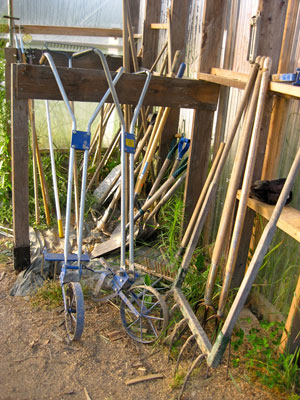 |
| Human power! From left to right: apprentice Kate Harris with rake, manager Jon Ault with shovel, and apprentices Brenna Peak and Jim Church with a broadfork and pick mattock. Photo courtesy of Long Meadow Farm. |
By Holli Cederholm
Long Meadow Farm, located in West Gardiner, Maine, demonstrates a sustainable agriculture system based on low-input, low-tech organic farming. The 31.5 acres (2 acres cultivated for vegetables) is a vision of principles in practice, of ideologies carved out by hours of hard work – done mostly by hand. In 2012 Denis Thoet, farmer and farm owner, and Jon Ault, farm manager and MOFGA journeyperson, along with three apprentices are continuing this operation’s longstanding tradition of human-powered farming.
Thoet bought Long Meadow himself in 1998. He and his now ex-wife Michele Roy gardened there together from 2001 to 2011. Roy had gardened elsewhere since the ’70s. In 2004, their home gardens grew to support the start of their Community Supported Agriculture (CSA) program – then with just three members. Along with one apprentice, they tended a 25- x 350-foot plot by hand, following an initial round of rototilling in 2003 to break ground.
“We traded our rototiller for a gallon of maple syrup … and we got the better deal,” says Thoet.
A Labor of Love
Thoet believes that using hand tools is just as effective as farm machinery on the 2 acres under cultivation for the farm’s 80-member, 20-week vegetable CSA. “One human being is about two-tenths of a horse. We have five human beings here, so it’s about one horse,” says Thoet.
Even horsepower doesn’t appeal to Thoet as it requires a mechanical inclination to maintain the equipment. Over the years, however, Thoet has managed an assemblage of livestock, from Jersey steers to Icelandic sheep to Angora goats to the current mix of 40 Golden Red laying hens, a hive of bees and five turkeys.
 |
| Farm owner Denis Thoet in his seedling propagation house. Cederholm photo. |
When it comes to farm equipment, Thoet says, “A wheel hoe is much more human friendly.”
Ault agrees. “I’ve never used a tiller … this is the only type of farming I know.” Ault left Pittsburgh, Penn., and a job in the finance sector in 2011 to apprentice at Long Meadow.
“It’s almost like a very big garden,” says Ault, reflecting on the tools and techniques used in a human-power-based farm system.
Long Meadow’s fields are indeed like a series of gardens, with some encircling the main farmhouse and attached seedling house and the majority clustered around the larger greenhouse. Small fields were integrated into the farm system in different years, and standards such as uniform bed length and headlands weren’t as necessary as on tractor- or draft-powered farms.
Each season starts in the living room of the farmhouse, Long Meadow’s primary seed propagation station. Seeds are started under grow lights and along windowsills before being moved to a west-facing adjacent atrium. Before planting, seedlings are hardened off in another unheated structure.
Seedlings are then transplanted into raised beds, prepped annually to increase drainage capacity of the clay soil. Each fall two-thirds of Long Meadow’s field space is cover-cropped with easily incorporated, winterkilled crops such as buckwheat and oats. Spring integration relies on wheel hoes; Thoet prefers the American-made Valley Oak model. He works the beds with a combination of attachments, including a four-tine cultivator (also used to remove quackgrass from beds and pathways), a 12-inch stirrup hoe and multiple passes.
Preparation also depends on bed rakes, broad forks and pick mattocks – a pick ax with a flat blade used to break up heavy soils through a modified golf swing. The pick mattock is Long Meadow’s primary sod removal tool.
Human power extends beyond prepping beds and hand weeding to maintaining field edges by scything, raking cut hay and spreading mulch by hand.
Pest management relies on hand picking bugs and using floating row covers, rather than spraying organic pesticides. Best practices are also important; cover cropping, timing and interplanting all play a role in this farm management system.
Interplanting maximizes the use of space. At Long Meadow, a bed never stays empty for long. When a crop is finished, a bed is amended and planted with a new crop or two. “We try to interplant as much as possible,” says Ault.
 |
| The tools of the trade: Long Meadow has a full supply of wheel hoes, broadforks, pick mattocks, shovels and rakes. Photo courtesy of Long Meadow Farm. |
Favorite bedfellows include broccoli and head lettuce. Greenhouse tomatoes are always sandwiched between rows of basil, fall carrots or Swiss chard.
Powered by and Empowering Apprentices
“This type of farming takes apprentices, time, labor,” says Ault. And that’s okay with him. Ault believes that as fuel resources decline and the labor economy needs to grow, farming will depend on less mechanized systems such as Long Meadow’s.
Long Meadow has hosted apprentices from the start – with a single apprentice in the first and second years and three to five annually since then. Apprentices get life experience, room, board and a stipend. “MOFGA’s apprentice program has been the best thing for us,” says Thoet.
Ault adds, “We need a community pretty steeped in agriculture to make this system work.”
Luckily for Long Meadow, their work ethic seems to attract prospective and like-minded workers.
Kate Harris, Ault’s partner and a 2012 Long Meadow apprentice, worked on horse-powered Darthia Farm in Gouldsboro, Maine, last season. Harris says, “It’s a much more intimate relationship with the soil… we’re literally, by hand, picking up the weeds.”
The crew averages nine-hour days during the week, and Thoet, Ault and Harris log extra hours on weekends.
Thoet says, “Its hard work, but it’s fun work. People who don’t like it don’t do it.”
Local, Local, Local
“We’re mission driven, not profit driven,” says Thoet. “Our goal is to provide as much food on this piece of land for local people as is possible. Our focus is local, local, local.”
West Gardiner has only one other farm, so Long Meadow can advertise pretty close to home. The majority of its 80 CSA members pick up weekly right at the farm. Thoet delivers a small percentage of CSA shares en route to other markets. Long Meadow sells its produce and free-range chicken eggs at the Gardiner Farmers’ Market on Wednesdays from 3 to 6 p.m. and to a handful of local wholesale accounts, such as Waterstreet Cafe.
Customers who pick up shares at the farm can see how their food is grown and, if they wanted to, could apply most of the practices in smaller gardens. Ault mentions the only real difference is scale, and perhaps the 26- by 96-foot season-extending hoophouse.
“We’re showing local people that they can do it too,” says Ault.
Long Meadow is open for garden tours Tuesdays, Fridays and weekends if you call ahead. For more information, visit www.longmeadowfarmmaine.com.
About the author: Holli Cederholm was MOFGA’s farmer in residence, with Brian St. Laurent. Their Proud Peasant Farm is now located in Washington, Maine.
